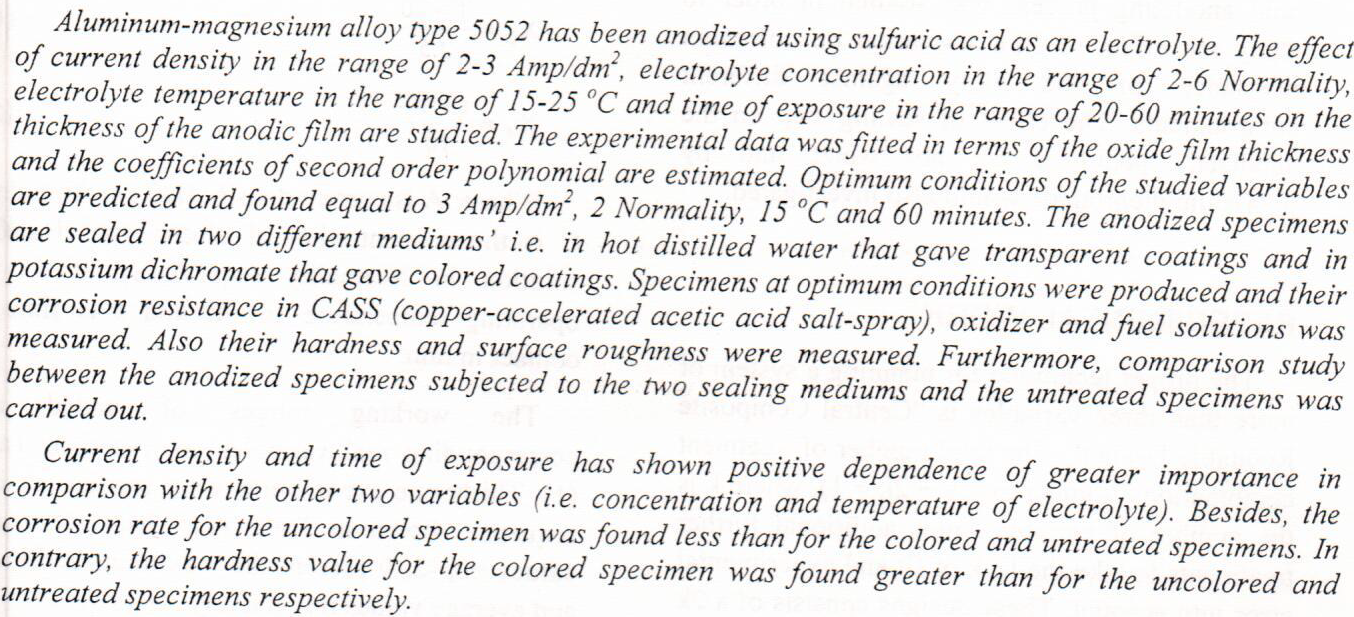
The research involved attempt to inhibit the corrosion of Al-Si-Cu alloy in 2.5x10-3 mol.dm-3 NaOH solution (pH=11.4) by addition of six different inhibitors with three concentrations (1x10-3, 1x10-2, and 0.1 mol.dm-3). These inhibitors include three organic materials (sodium acetate, sodium benzoate, and sodium oxalate) and three inorganic materials (sodium chromate, disodium phosphate, and sodium sulphate). The data that concerning polarization behaviour are calculates which include the corrosion potential (Ecorr) and current density (icorr), cathodic and anodic Tafel slopes (bc & ba), and polarization resistance (Rp). Protection efficiency (P%) and activation energy (Ea) values were calculated for inhibition by the six inhibitors. The
... Show MoreIn this study, a 3 mm thickness 7075-T6 aluminium alloy sheet was used in the friction stir welding process. Using the design of experiment to reduce the number of experiments and to obtain the optimum friction stir welding parameters by utilizing Taguchi technique based on the ultimate tensile test results. Orthogonal array of L9 (33) was used based on three numbers of the parameters and three levels for each parameter, where shoulder-workpiece interference depth (0.20, 0.25, and 0.3) mm, pin geometry (cylindrical thread flat end, cylindrical thread with 3 flat round end, cylindrical thread round end), and thread pitch (0.8, 1, and 1.2) mm) this technique executed by Minitab 17 software. The results showed th
... Show More (4)
(4)
Formation of Au–Ag–Cu ternary alloy nanoparticles (NPs) is of particular interest because this trimetallic system have miscible (Au–Ag and Au–Cu) and immiscible (Ag– Cu) system. So there is a possibility of phase segregation in this ternary system. At this challenge it was present attempts synthetic technique to generate such trimetallic alloy nanoparticles by exploding wire technique. The importance of preparing nanoparticles alloys in distilled water and in this technique makes the possibility of obtaining nanoparticles free of any additional chemical substance and makes it possible to be used in the treatment of cancer or diseases resulting from bacterial or virus with least toxic. In this work, three metals alloys Au-Ag-Cu
... Show More (2)
(2)
The optimal combination of aluminum quality, sufficient strength, high stress to weight ratio and clean finish make it a good choice in driveshafts fabrication. This study has been devoted to experimentally investigate the effect of applying laser shock peening (LSP) on the fatigue performance for 6061-T6 aluminum alloy rotary shafts. Q-switched pulsed Nd:YAG laser was used with operating parameters of 500 mJ and 600 mJ pulse energies, 12 ns pulse duration and 10 Hz pulse repetition rate. The LSP is applied at the waist of the prepared samples for the cyclic fatigue test. The results show that applying 500 mJ pulse energy yields a noticeable effect on enhancing the fatigue strength by increasing the required number of cycles to fracture the
... Show More (1)
(1)
This paper presents the Taguchi approach for optimization of hardness for shape memory alloy (Cu-Al-Ni) . The influence of powder metallurgy parameters on hardness has been investigated. Taguchi technique and ANOVA were used for analysis. Nine experimental runs based on Taguchi’s L9 orthogonal array were performed (OA),for two parameters was study (Pressure and sintering temperature) for three different levels (300 ,500 and 700) MPa ,(700 ,800 and 900)oC respectively . Main effect, signal-to-noise (S/N) ratio was study, and analysis of variance (ANOVA) using to investigate the micro-hardness characteristics of the shape memory alloy .after application the result of study shown the hei
... Show MoreThe effect of different cutting fluids on surface roughness of brass alloy workpiece during turning operation was carried out in this research. This was performed with different cutting speed, while other cutting parameters had been regarded as constants(feeding rate , and depth of cut). Surface roughness of machined parts that will be tested by electronic surface roughness tester .The results show that the standard coolant gives the best values of surface roughness for fixed cutting speed ,followed by sun flower oil that has approximately the same effect, while the air stream as a coolant gave unsatisfied results for the evaluation of surface roughness.
In the other hand the best values of surface roughness were recorded for max
... Show More (3)
(3)
A theoretical analysis studied was performed to study the opacity broadening of spectral lines emitted from aluminum plasma produced by Nd-YLF laser. The plasma density was in the range 1028-1026 )) m-3 with length of plasma about ?300) m) , the opacity was studied as function of plasma density & principle quantum number. The results show that the opacity broadening increases as plasma density increases & decreases with the spacing between energy levels of emission spectral line.
Abstract: Aluminum alloys grade 6061-T6 are characterized by their excellent properties and processing characteristics which make them ideal for varieties of industrial applications under cyclic loading, aluminum alloys show less fatigue life than steel alloys of similar strength. In the current study, a nanosecond fiber laser of maximum pulse energy up to 9.9 mJ was used to apply laser shock peening process (LSP) on aluminum thin sheets to introduce residual stresses in order to enhance fatigue life under cyclic loading Box-Behnken design (BBD) based on the design of experiments (DOE) was employed in this study for experimental design data analysis, model building and optimization The effect of working parameters spot size (ω), scannin
... Show More (1)
(1)
Background: Nowadays there is an increasing of the emphasis on aesthetic, dentist have been concerned about providing aesthetics and functional removable partial dentures to their patients and this was make the mission more difficult because of the goal now is achieving optimal aesthetic of the denture - while maintaining retentive, stable, and conservative to the health of supporting tooth and supporting tissue. The traditional use of metal clasp like cobalt-chromium, gold, stainless-steel and titanium hampers esthetics because of its obvious display conflicts with patient’s prosthetic confidentiality. Acetal resin (poly oxy methylene) may be used as alternative denture clasp material. This material was promoted primarily on the basis of
... Show More